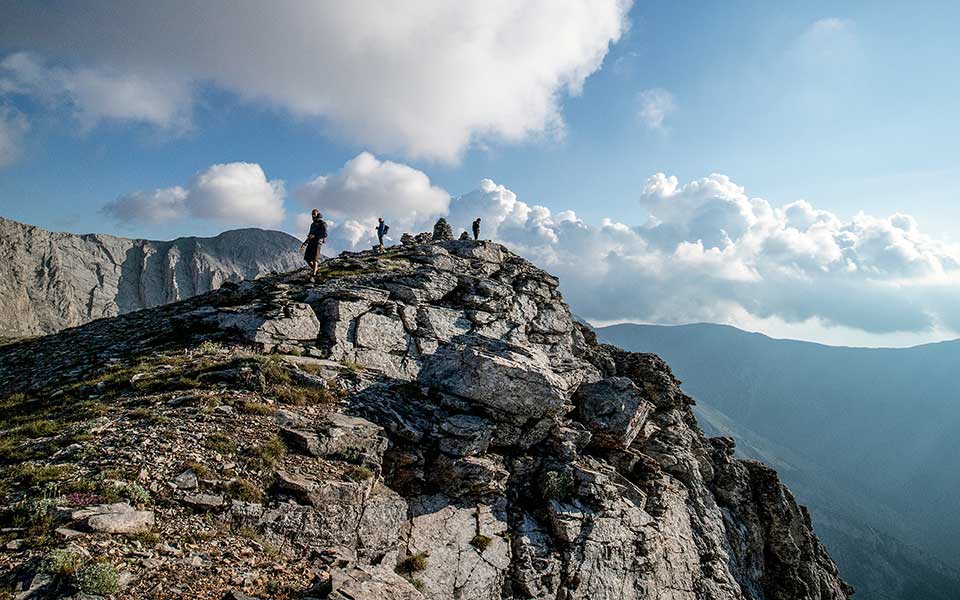1. GREETINGS FROM ZEUS ON MT OLYMPUS, JULY, 1980s
We (three adults, three teenagers) had taken the train from Athens to Litohoro, where we spent the night, hiring a taxi the next day to take us to the first refuge. From there, we walked up to the second refuge on a fairly gentle path shaded by trees and strewn with wild flowers. After lunch there, the younger ones crashed but I ventured out for a postprandial stroll on the mountain. One of my companions had the same idea and we started walking, never intending a major climb. Without realizing it, we found ourselves fairly near the summit and were debating whether to continue, when suddenly, the blue sky turned black, thunder rattled round the curved slope and hail pelted from above. We took shelter under a ledge and watched as the mountainside turned white. Zeus had revealed himself, still very much alive in his kingdom. The others made it to the peak of Mytikas the next day, while I nursed sore toes, bruised in the steep descent.
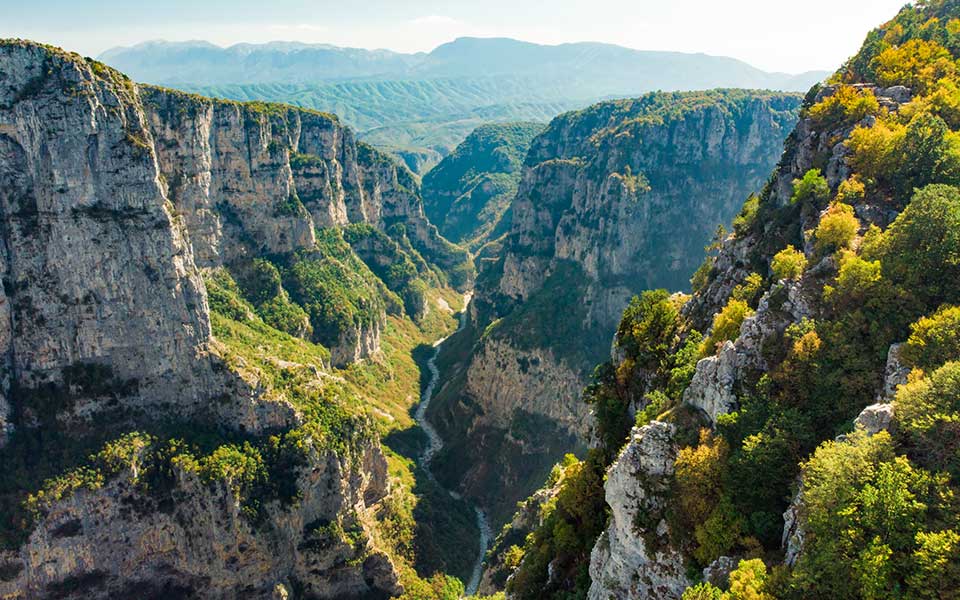
© Shutterstock
2. “DOING” THE VIKOS GORGE IN SUMMER, EARLY 1980s
With pre-election propaganda blaring in Athens, about eight of us escaped to Epirus to walk the famous gorge. Our guide shepherded us down a vertical “ladder” path at Monodendri to the track that runs parallel to the river. It was surprisingly bare, few things growing on the steep slope, and very hot. After a few hours, we reached an enticing translucent pool so icy that only a couple of intrepid females dared to dip. We had a snack on its banks before making the almost vertical ascent back up to somewhere near Papigo. One of our party, a 40-year-old smoker, collapsed on the way but we coaxed him to the path’s end and then watched in disbelief as our guide scampered like a goat further up the mountain while we sat utterly exhausted, waiting for a pickup truck to take us to our hotel.
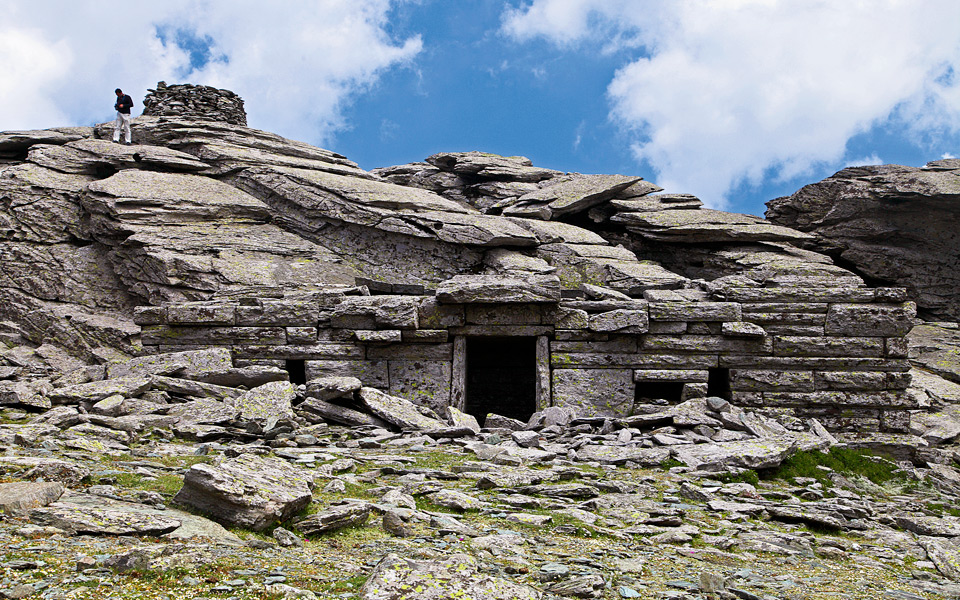
© Olga Charami
3. MEETING PAN ON MT OCHI, EVIA, LATE OCTOBER, 1980s
We parked near a chestnut forest on the eastern flank of the mountain and climbed up to the summit, where Zeus and Hera were allegedly betrothed. If we’d gone up the south slope, we would have passed countless granite columns, lying like logs, some only half-formed, abandoned as though the Roman quarriers had left in a hurry. But this time our aim was to see the Dragon House, perhaps an 8th c. BC shrine to the goddess Hera, but so named, or at least so I’ve heard, because these houses seem to sometimes puff out clouds, like smoke from a dragon’s mouth, as mist escapes through gaps in their roof slabs. Just after we’d inspected it, a dense fog descended without warning. My friends disappeared from view and silence reigned, until minutes later I heard a clanging bell. Spellbound, I watched as the form of a large goat emerged from the grayness. Could it have been Pan?
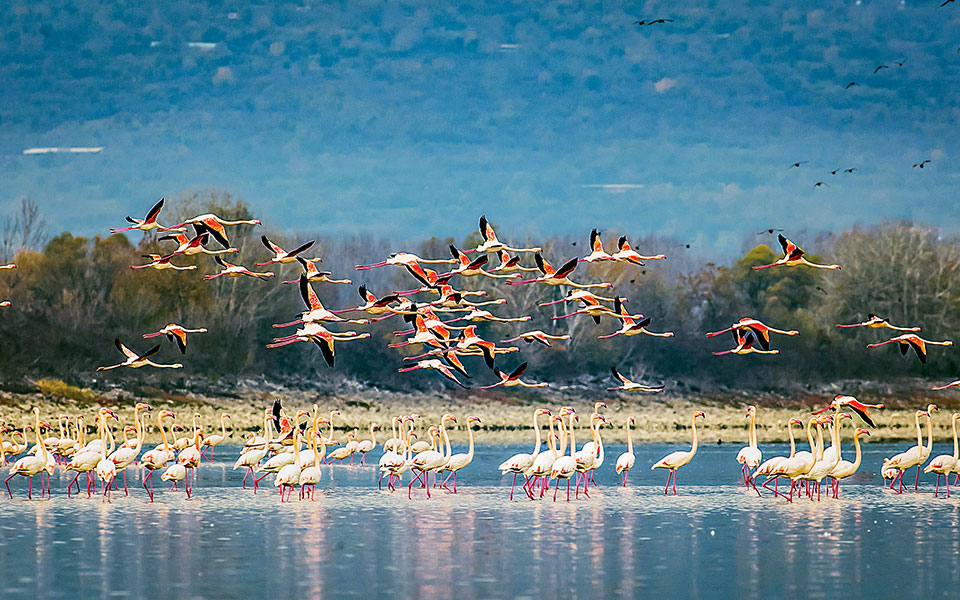
© GEO Pictorial/George S Blonsky
4. BIRDING ON LAKE KERKINI, MAY, 2005
Fish break the water’s surface over and over in an eccentric rhythm, sleek cormorants and grebes with blond crests disappear under the metallic surface of the lake, and several Dalmatian pelicans float serenely by, causing barely a ripple. At intervals along the shore, blue herons are standing like sentinels among the grasses while beige squacco herons, a third their size, perch in the branches of dead trees. A night heron, black as its name, streaks across the water in front of our plava, the narrow, flat-bottomed boat common to Macedonia’s lakes. A herd of water buffalo wade in to bathe and drink, and our guide points out rooftops in mid-lake, from a village drowned when the reservoir was built (scenes of this were immortalized in Theo Angelopoulos’ “Trilogy: The Weeping Meadow”). “This is the richest wetland in Greece for birds, more than 300 varieties,” the guide tells us, “but you should see it in October, when patches of the lake turn pink, there are so many flamingos!” I could have floated there forever.
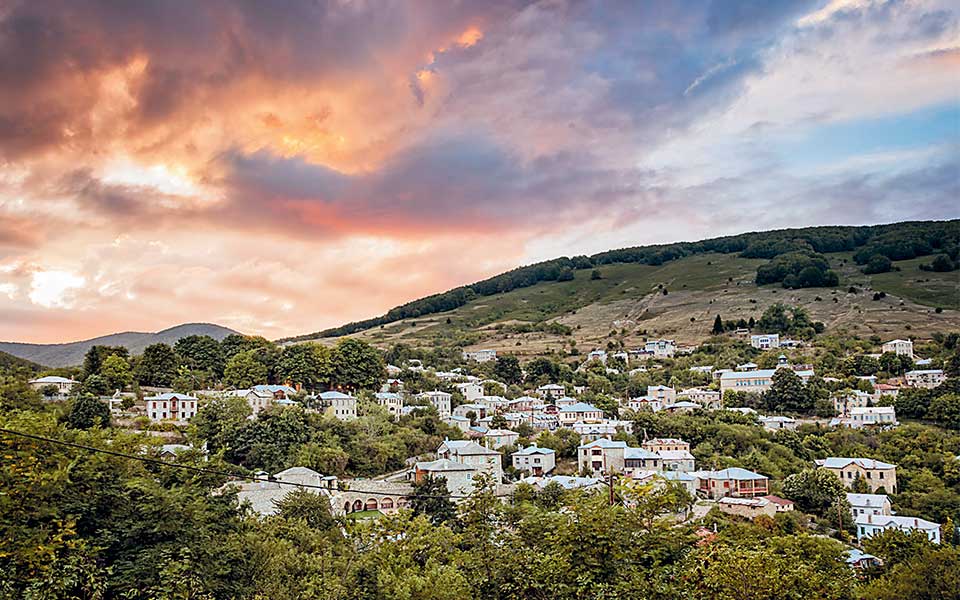
© Perikles Merakos
5. NYMPHAIO, EARLY 2000s
With its gray stone houses, immaculate cobbled paths and its monumental school and church, Nymphaio lived up to its reputation as the most beautiful village in northern Greece. Pink and white peonies bloomed in its gardens, firs and plane trees towered over them, and there were no cars. Instead, horses were roaming freely, grazing in the main square, ambling up and down the lanes. There were hardly any people. Rebuilt in the 1980s by a Vlach-speaking group led by writer Nikos Mertzos and the winemaker and later mayor of Thessaloniki, Yiannis Boutaris, the village could have been a movie set for “The Sound of Music,” but the only time it came alive was when a school bus arrived at the nearby Arcturos Bear Sanctuary or later at the Wolf Sanctuary. It seemed a shame that such a lovely spot, rebuilt with such care, should be nothing more than a retreat for weekenders. We did find it amusing, though, that Boutaris’ mother lived there with a Filipina maid who spoke Vlachika, not Greek.
6. CHERRY CHEER IN KISSAVO, MAY, 2005
Who knew that Ossa was the same mountain as Kissavo! The Titans wanted to pile Ossa on Pelion to get to Olympus, but for us, it was more like the Garden of Eden. It was cherry season and we walked through orchards where Albanian pickers were at work; one named “Clyde” handed us each a handful. Unlike Pelion, Kissavo’s towns such as Aghia and Metaxohori make so much money from fruit, especially apples, they don’t need tourists. We also stumbled upon a hotel decorated with hand-painted maps of the area: watercolors showing Aghia’s 23 churches and the south face of the mountain with its 43 landmarks. The artist even drew us our own map to make our hikes easier, and as we halted, hot and sweaty, at a café under an enormous plane tree, the owner served us tsipouro, a local spirit he pronounced as “Chipouro,” and delicious spring water, ouzo being nonexistent in these parts. “Why don’t you come back in October and walk when it’s cooler?” he asked. Kissavo has all the attractions of Pelion – architecture, scenery, cafés, food – without the crowds. There is a distinct pleasure in visiting a place that has no need for visitors.
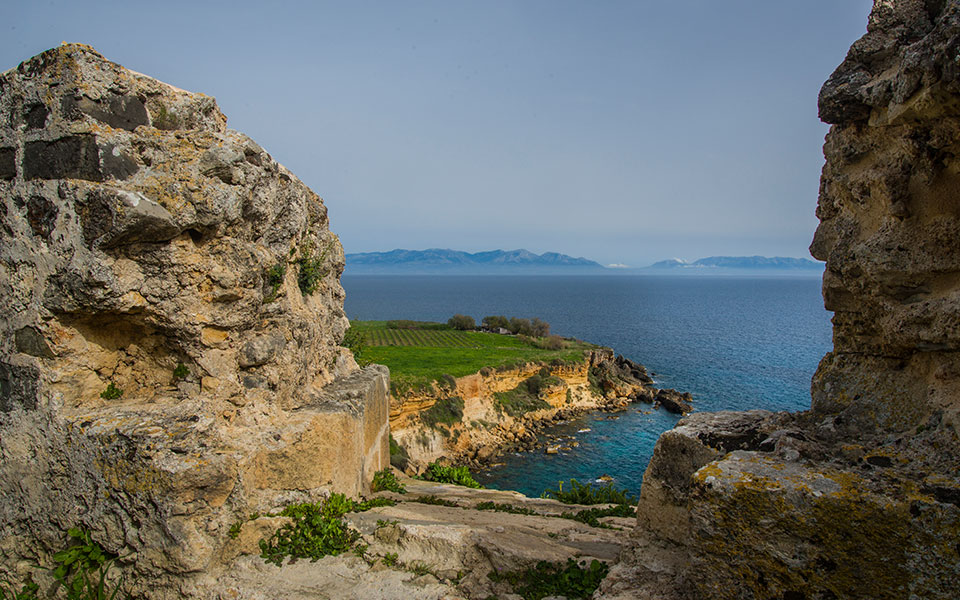
© Clairy Moustafellou
7. MAGIC BEANS IN KORONI, MAY, 1974
After spending Easter on Spetses, I packed my 7-year-old son and a few bags into our Fiat 500 and, inspired by Kevin Andrews’ “Castles of the Morea,” set off to explore the Frankish castles of the Peloponnese. We’d “done” Mystra and Pylos and were walking around the upper part of the Venetian fortress at Koroni when I spied a gate in the high walls that opened onto a garden. We ventured in for a peek, and then saw something irresistible – a patch of koukia, fava beans, in pods as long as boars’ tusks, plump and ripe. The two of us had been introduced to the delicious combination of raw koukia and salami when we’d lived for a year in Italy before moving to Greece in 1972, and I just happened to have some salami, cheese, fruit and bread in my rucksack for a picnic. We looked around furtively – not a sign of any onlookers – and quick as a wink started plucking pods from their stalks. We weren’t greedy and, with about a dozen in hand, we snuck out again and had a picnic to remember, perched on a thick wall with a view of the sea.
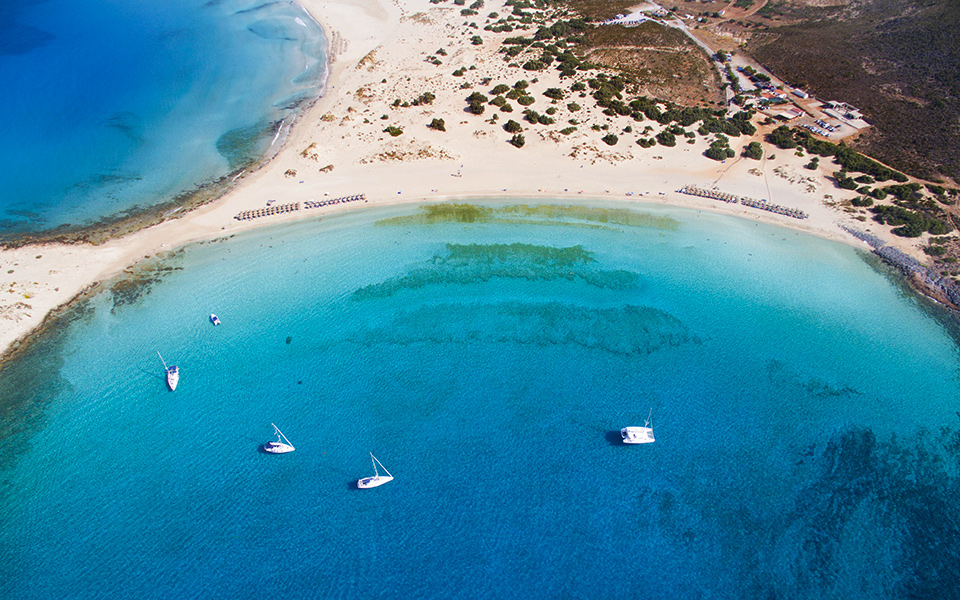
9. ELAFONISOS, EARLY SEPTEMBER, 1974
Neither of us has any recollection of how we chose this tiny island as the spot for our first illicit holiday. Perhaps because it was so remote there was no chance of being discovered. The one village stretched along the north coast, divided by a pier lined with fishing boats. We found a room on the east side, on the ground floor, with nothing separating us from the passersby on the narrow sand-paved street but a flimsy curtain over a screen door. I remember the public phone room, where you sat and waited your turn with the operator; privacy was not an option. I also remember the island’s eateries, two or three tavernas. The best one, which would have been special anywhere, was run by the mayor, a portly Robert Morley lookalike, who used to inspect the day’s catch wearing a safari jacket and helmet, and then turn it into a Michelin-quality fish soup. Every morning, we’d turn up there to place our order for dinner. Nowadays, the island’s south shore beach is renowned but back then we had no idea anything so beautiful existed in Greece. With its gentle white sand dunes framed by prickly cedar trees and turquoise water, it could have been in Tahiti. And it was empty.

